YES, WE HAVE NO BANANAS (title of 100-yr-old song)
I Receive a Giant Teardrop
Since I don’t live in the tropics, I bring a bit of it into my house. Hence, the banana tree that, years ago, tropicalized my living room for a number of winters. The plant made a nice houseplant for awhile, its large leaves jutting into the air like velvety, soft, green wings. Pests never bothered it. It even signaled to me when it was thirsty by drooping its leaf blades down along its midribs.
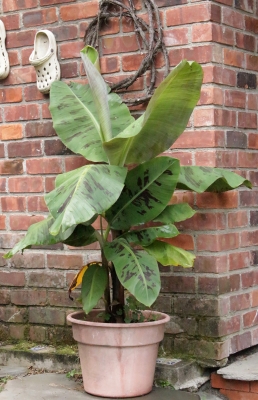
Banana plant in summer
But mind you, I was not growing this plant only for show. I also wanted to harvest bananas. In the warm tropics, bananas fruit when they are only ten to fifteen months old; in a warm greenhouse, plants fruit in two or three years; in my sixty to seventy degree, sometimes colder, house . . . well, fruit was a goal, but I was in no particular hurry.
The plant that I received in the mail seemed a sorry beginning for a luxuriant, tropical plant. Inside the packing box was a banana rhizome, about the size of a baseball and looking like a giant, dirty white teardrop. I potted it up, pointed end up and protruding above the soil, and supplied warmth and water. Soon, something thin and green poked straight up out of the soil. This green thing turned out to be a rolled up leaf, which soon unfurled, only to be followed by another, and another, and another.
Happy in Summer, Not So Much in Winter
A banana plant never really becomes a tree, but is a treelike perennial herb. The “trunk” of a banana tree is a pseudostem, made up of rolled up leaf stalks, with that of the oldest leaf outermost. From around the base of the plant, additional pseudostems periodically grow.
When ready to flower and fruit, a pseudostem sends up from its center a flower stalk rather than another rolled up leaf. After fruiting, a pseudostem dies, but the plant lives on in the growth of “pups,” baby pseudostems that form around the base.
Through the summer, my banana tree rapidly grew, and its pseudostems thickened so much that I had to repeatedly repot the plant to keep it from bursting out of its pot. That was the first problem with the plant: it was getting too big for my house.
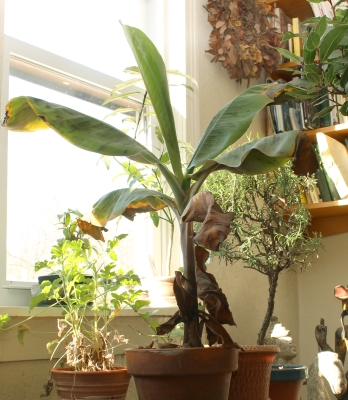
Banana in early autumn
My plant, a ‘Dwarf Cavendish’, was supposed to grow only six feet tall, but that depends on how you measure its height. The rolled up leaf keeps pointing straight up until it unfurls, then the open leaf flops down alongside its neighbors. Until the leaf unfurls and flops down, you have to add another three feet to the height of the plant.
The second problem that eventually arose was that the plant really didn’t enjoy winters indoors in my cool house.
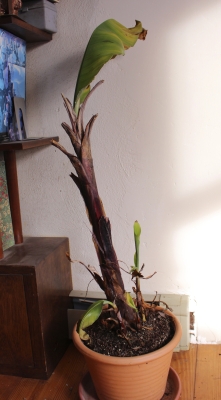
Banana in winter
A banana tree is happiest basking in warm sunlight, with gentle, moisture laden breezes caressing its leaves, and the temperature never dropping below a balmy 65 degrees.
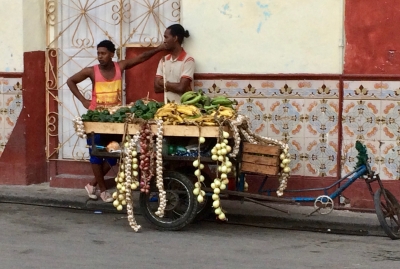
Cuba, where bananas are happy
By comparison, the air in my house is cold, still, and dry in winter. Compared to Trinidad or Barbados, my sunniest window is relatively dark in winter, when the sun rises late, sets early, and hangs low in the sky even at midday. Each spring, when I moved the banana tree outdoors, its leaves were ragged and yellowing.
I never did harvest even one banana from my plant. Periodically, as the largest pseudostem outgrew my house, I would remove a small offshoot, pot it up, and discard the mother stem. No stem ever got old enough to fruit.
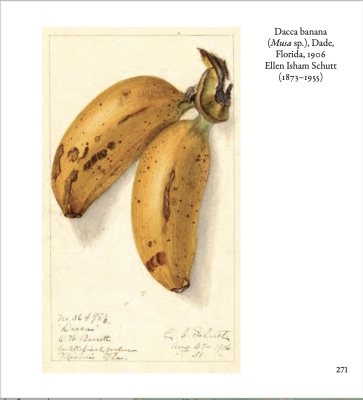
A plug for my book Fruit: From the USDA Pomological Watercolor Collection; one of the beautiful, 100-yr-old watercolors
Eventually, it seemed too cruel to subject the plant to another winter indoors, I lost interest in the plant, and relegated the whole thing to the compost pile.
But…I’m getting Back in the Game
After a number years banana-less, I might take up the sport again — this time outdoors! In the last few years, a number of “hardy bananas” have been showing up in garden catalogues and online. Obviously, not just any old banana plants, but different banana species.
Some of the cold-hardy species include Pink Banana (Musa velutina), with beautiful, pink fruits, Yunnan Banana (M. yunnanesis), and Saba Banana (M. babisienses).
But the most cold hardy of bananas is Basjoo Banana (M. basjoo). This one can survive temperatures of Zone 7, where winter lows plummet from ten to zero degrees Fahrenheit. But my farmden isn’t in Zone 7; it was, until recently in Zone 5, but, with global warming, was recently upgraded(?) to Zone 6, where winter lows drop from zero to minus ten degrees.
At forty degrees Fahrenheit, growth of a Basjoo banana plant screeches to a halt. At thirty-two degrees Fahrenheit, the leaves are killed. My plan, at that point would be to cut whatever’s left of the plant down to the ground, then mulch it with wood chips. Remember the rhizome? It’s reputedly cold hardy to minus ten degrees Fahrenheit. With a suitable thickness of mulch, underground temperatures would remain, if not ideal for the plant, at least warm enough for survival.

Hardy banana at Chanticleer Garden
(A well drained soil is also important for winter survival. Where drainage is poor, building up a mound of soil in which to plant would also tip the scale in favor of survival in marginal climates.)
It looks like I’ll have my bananas, but NOT eat them too. Basjoo banana, and the other cold hardy species, don’t bear fruit worth eating. Basjoo will create a small area in my garden of a lush, tropical paradise — only in summer, of course.

My friend Sara’s tropical oasis.


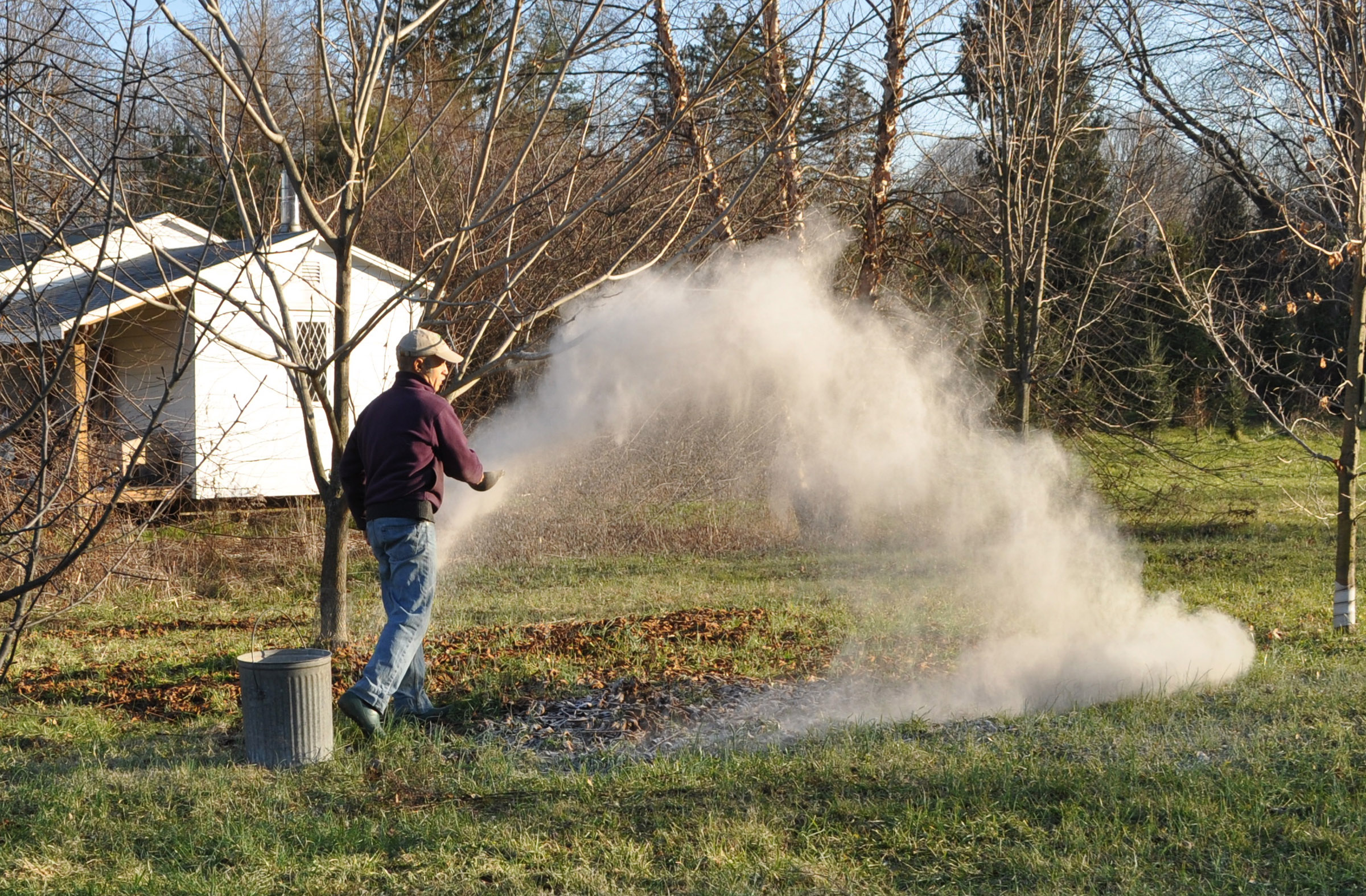

Here in Atlanta, decorative are common but we never get the two years of uninterrupted growth that are needed for fruit. Kids love the giant leaves, and the leaves are also great for outdoor table settings or as an alternative to paper plates (wash first, obviously).
Yes, a cool plant in so many ways, even besides the fruit.
Your bana tree is beautiful. Have patience, I see bananas in your future
Prema
Thanks, but that banana is no more. You’re right, though, there’ll be one in my future.